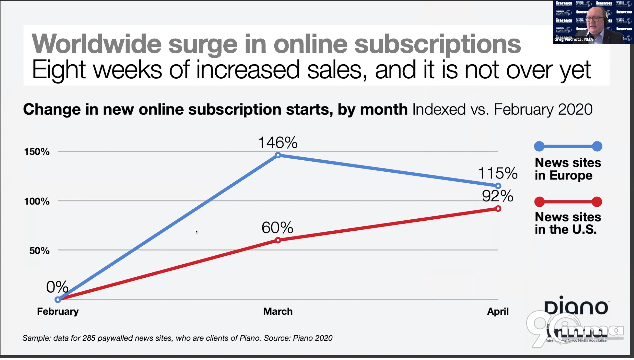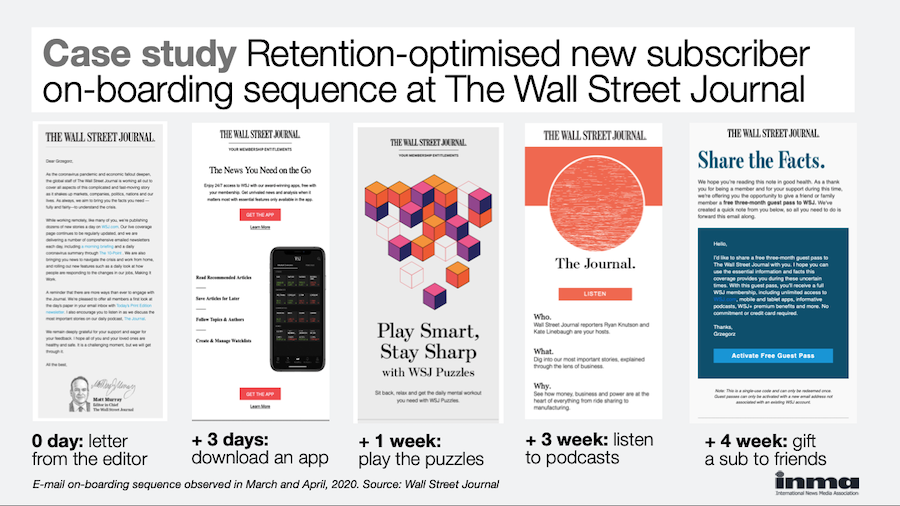
Most news organisations have seen a spike in website traffic and subscriptions over the past couple of months as people continue to seek out coronavirus-related news content. But data shows that new subscription sign-ups are not coming from new readers.
"Where do they come from then?", asked Grzegorz (Greg) Piechota, researcher-in-residence, INMA, at INMA Virtual World Congress (7 May 2020).
Data from the digital business platform Piano shows that since February 2020, US and European news sites have seen a continued subscriptions growth.

Picture: Screenshot of Greg Piechota's presentation, courtesy INMA
Although the peak seems to have passed around March 2020, the current rate of subscriptions growth is still higher than in the pre-pandemic times.
The same data shows that across nearly 300 paywalled news sites around the world, the average growth is close to 14 per cent. The New York Times, for instance, now has nearly 4 million subscribers to its digital news service and is approaching 6 million of total subscribers when taking into account all of its products, including lifestyle and audio. The first quarter of 2020 saw nearly half a million new subscribers to the online news compared to the last quarter of 2019.
What were the successful strategies behind these new acquisitions? According to Piechota, who studied 48 largest subscriptions-based news sites worldwide, around 15 of them decreased their prices to allow new readers to become familiar with their news products.
New introductory offers proved particularly successful to gain new subscribers. For example, Italian La Republica rolled out an offer for 1€ for three months, while The New York Times offered new readers a trial for US$ 1 a week for one year, leaving them a much longer runway to experience the website and familiarise themselves with it.
But when we look closer, said Piechota, it is not the new readers who are driving the subscriptions growth related to coronavirus news. Data by Deep.BI shows that it is the most engaged readers and longtime website users who are fuelling the bump.
According to the same data, new readers require more time to engage with a website before taking out subscriptions. So if your organisations relies on subscriptions for revenue, it pays off to engage your future audience early on. One way to do that is to offer free subscription to students, like The New York Times.
But spikes have one nasty habit. At some point, the numbers will start to fall as subscribers will cancel their subscriptions (churn). To prevent a dramatic exodus, you need to understand what keeps subscribers coming back for more.
The Wall Street Journal has attempted to pinpoint the moment at which readers cancel their subscriptions. Looking at their behaviour, the publisher found that playing puzzles was key to retaining new subscribers between one and three weeks after sign-up.

Screenshot from Greg Piechota's presentation, courtesy INMA
Data show that other forms of journalism are also important. Piechota presented data from Chartbeat that showed live blogs have been outperforming other types of news content when measuring audience engagement.
Developing a truly reader-centric approach
Robbie Kellman Baxter, author of "Forever Transaction" and media consultant offered more tips on preventing churn, also speaking at the INMA Virtual World congress.
She recommended examining previous spikes and identifying the readers who stayed and who left.
The next step is to pinpoint the differences between those two groups. Make the best possible guess about why your best subscribers stuck around and develop a hypothesis by looking at how their behaviour differs from other readers in the hours, days and weeks after sign-up.
When you detect a particular interest in a topic or a feature like customising online experience, you can assume this is what they care about and test it with your new subscribers.
Baxter added that consumers are also more open to experimentation during the coronavirus pandemic because they require new solutions to disrupted regular habits. This is a great opportunity for news publishers to meet reader needs. For example, many people were receiving a newspaper to their office but now are working from home.
No matter what you do, however, some subscribers will still want to cancel. Here is one valuable lesson publishers can learn from Netflix: make the cancellation process easy.
Although it may sound counterintuitive, hiding the cancel button is unwise. People will get frustrated and when they finally manage to cancel their subscription, they are unlikely to ever come back. Conversely, making the cancellation process simple appears to help win customers back in the future.
Should covid-19 news be free?
This is a tough question that all news organisations have been grappling with. On the one hand, news is essential for people, now more so than usual. But for reporting to be sustainable, it needs to be financed.
Very few other sectors would start giving their products out for free when the demand spikes. But the ethical obligation that journalists have towards their readers shows that the news is unlike any other product.
According to Piechota, of the top 50 news subscription publishers he studied, around one third have unlocked all or some of the pandemic coverage for all users for free. And while we are still awaiting more data, it seems that even when readers have a choice to get their news from trusted public service media, they are still willing to subscribe to an online news website.
Has your news website seen a spike in trafic and subscriptions? How are you planning to retain new subscribers? Get in touch at @journalismnews
Also, check out Journalism.co.uk online training courses here to sharpen your skills while working from home.
Free daily newsletter
If you like our news and feature articles, you can sign up to receive our free daily (Mon-Fri) email newsletter (mobile friendly).
Related articles
- Meet the media innovator breaking down barriers between Polish and Ukrainian women
- Six self-care tips for journalists to stay sane during the US election
- How The Economist reached young audiences through new formats and brand marketing
- UAE's The National uses free reader registration to counter the decline of SEO
- How to get started with user needs: learnings from the Reuters Institute, Metro.co.uk and smartocto









